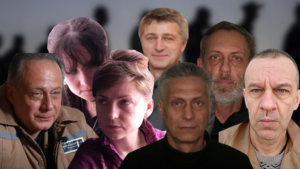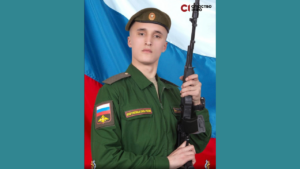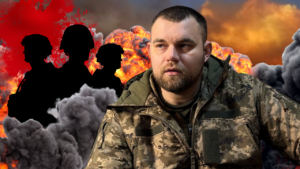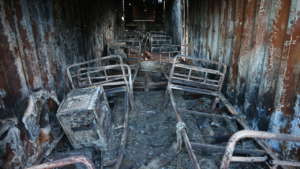Hitting a hospital from a tank: Two Russians sentenced for shelling of a medical facility in Trostianets
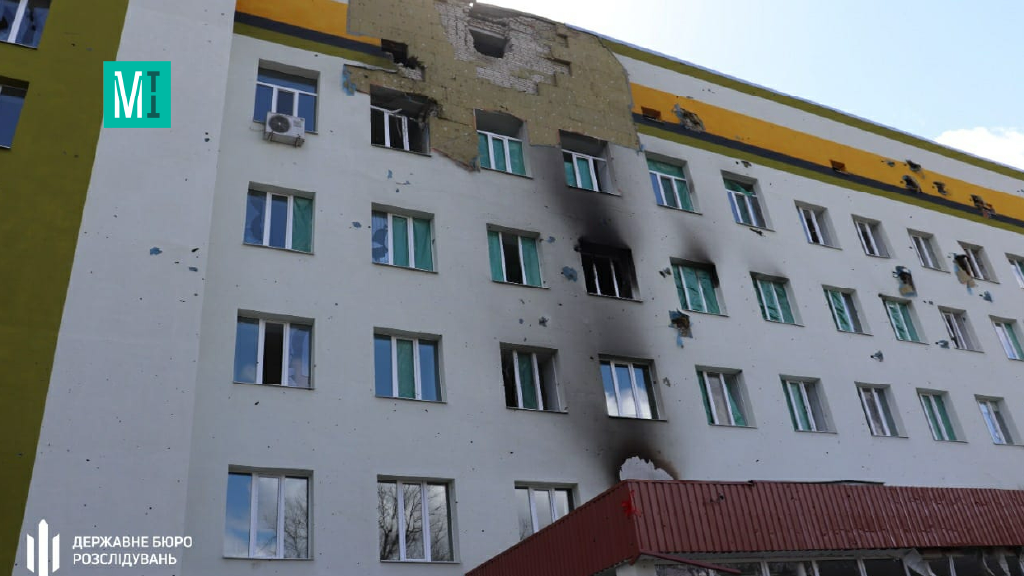
Russian tanks shelled Trostianets City Hospital in Sumy Region in March of 2022 during the occupation of the city. The hospital suffered significant damage. The tankmen who could have been involved in the shelling of the medical facility have been established by law enforcers: those are Junior Sergeant Pyotr Smirnov, the tank commander, and Aynur Mukhametkhanov, the gunner.
On May 9, 2023, Trostianets District Court sentenced them to 11 years of imprisonment. The MIHR journalists followed the case of the Russian tankers. We tell about the trial and the reasons for the court’s verdict.

Merits of the case
In March of 2022, Russian military convoys moved via settlements of the Sumy Region, including Trostianets. On the evening of March 18, at about 17:45, a T-72 tank approached Trostianets City Hospital and fired a high-explosive fragmentation charge from a 125-mm tank gun.
The court found that the order had been given by Pyotr Smirnov, the tank commander, and Aynur Mukhametkhanov had made the shot.
Their actions are qualified under Article 28, Part 2 and Article 438, Part 1 (violation of the laws and customs of war committed with prior concert) of the Criminal Code of Ukraine. What they did is punishable by a custodial sentence for a period from 8 to 12 years. The trial took place in absentia. The accused are wanted.
Evidence
The weapon of the offense, a tank, was left in Trostianets after the Russians departed. The investigation, with the participation of an expert, confirmed that the shot had been made from a T-72 tank. The documents of the Russians were found therein, which included the list of servicemen’s names. It is stated in the list that Smirnov is the crew member in the position of commander, and Mukhametkhanov is the crew’s gunner. The list also includes the dates of birth and the information on the education, the place and time of conscription, and the parents.

The data found correspond to the card from the passport system of the Russian Federation obtained concerning Mukhametkhanov. In the right part of the tank turret, where the commander’s seat is located, the investigators seized a purse with the military ID in the name of accused Smirnov.
The experts on the subject matter concluded that, given the nature of the damage, the shot on the hospital building was made from where the tank stood.
The forensic construction, technical, and military expertize established that the hospital’s losses inflicted by the shelling amounted to UAH 140,200 (approximately 3,500 euros).
What was told by the witnesses
The hospital personnel and patients confirmed that they had seen a tank approaching the hospital through the windows. When they had come down to the basement, they heard a shot. The driver of the medical facility testified that he had seen the tank traversing its turret toward the hospital and heard the shot and the sound of hitting the building. The investigative experiment with his participation confirmed that the witness had been able to see the tank from his spot in the medical facility.

The testimony of a woman who lived in a house opposite the hospital was key evidence. Through the apartment window, she had seen an IFV driving up to the hospital and letting out about ten persons with red armbands. In about ten minutes, a tank pulled up, letting out three servicemen in a bit different uniform. The military were talking and looking at the house, then returned to the IFV and tank and went towards the hospital. After that, a shot was fired from the tank.
The witness told that it had been still bright outside, and she had had enough time to discern the appearance of the two military from the tank, who were facing the windows. She remembered them well. She noted that one of the servicemen was taller, skinny, and fair-haired, and the other one was short, looked like a Buryat, and had a mole on his face.

During the pre-trial investigation, the lady recognized the servicemen among the photos provided by the investigation. The photo of Smirnov was obtained by the investigation from the passport found in the tank, and the photo of Mukhametkhanov was obtained from the passport system of the RF.
The medical facility personnel testified that white flags with the red cross had been installed at the entrance to the hospital. As it was not dark yet at the moment of the shot, it was hard not to notice them.
The medics told that the Russian military had previously come to the hospital and ordered for the personnel to wear white armbands. One of the employees testified that the Russians had known the location of the city hospital because they had brought a wounded woman there during the first days of the invasion.
All the witnesses confirmed that no servicemen of the Armed Forces of Ukraine or other military formations had stayed at the hospital. Only patients, pregnant women, in labor, or with newborns, and the personnel were inside. The witnesses informed that nobody had resisted the military of the Russian Federation’s armed forces in any way, and nobody had taken part in the armed conflict.
Position in defense
The defenders asked the court to acquit the Russians. They insisted that the investigation did not prove that the accused had been in the tank. The defense stated that the witnesses, namely the personnel and patients of the hospital, had not seen Smirnov’s and Mukhametkhanov’s faces and that they offered contradictory accounts.
Regarding the prosecution’s referring to the documents on the tank crew members, the defense does not believe that it is sufficient to conclude that those were the very servicemen who did the shelling.
Reasoning of the court
The court found the evidence of the prosecutor’s office justified. According to the court, the testimony of the woman who saw the tank through the window of the house is “logical, consistent, detailed and not contradicting the testimonies of the other interrogated eyewitnesses and the examined evidence”. The court took note that the originals of the documents in the name of Smirnov had been seized from the tank, and such documents stated that he had access to driving the T-72 tank.
The court found proven the prior concert due to the testimony of the same witness: the woman who had seen the military getting off the tank and talking before the shelling. the seized documents and military statutes, the court concluded on confirmation of the gunner’s accountability to the tank commander. The court also noted the expert opinion on the characteristics of the T-72 tank, and on the composition and location of its crew. According to such opinion, the crew consists of three persons: a commander, a gunner, and a driver-mechanic.
The eyewitness testimony that the hospital all signs of a medical facility was also taken into account: a flag with the red cross was visible at the entrance, ambulances were parked there, and the relevant road sign was on the road. Moreover, the Russians had visited that hospital before and were aware that that was a civilian facility.
The court stated: “It might have been obvious to the accused that the building to which they drove up by tank was a civilian facility, the attack of which is forbidden by international humanitarian law. The hospital was not used against the RF armed forces, which excluded the grounds for the defendants to consider it a military target. Given the circumstances of the incident and its consequences, the actions of the accused had no military need and did not lead to the achievement of a military goal, i.e., full or partial conquest of an enemy within the shortest time with the minimum loss of resources.”
As international humanitarian law, the Russian Articles of War and the Russian Criminal Code forbid to attack on civilian facilities, including hospitals, the court held that the Russian servicemen were to be aware of such provisions.
As a result, the court found both defendants guilty and sentenced them to 11 years of imprisonment. They will serve a sentence from the moment of their detention. The court also granted the civil suit of Trostianets Hospital to the Russian Federation for UAH 140,200 in damages. The verdict can be appealed within 30 days.
It should be noted that five non-government organizations, including the MIHR, have prepared Analytical Report, “Destruction and Devastation. One Year of Russia’s Assault on Ukraine’s Health Care System”. It has documented at least 707 attacks of Russia against the medical infrastructure and personnel. Ukrainian human rights advocates voiced the information from the report at the meeting of the 52nd Session of the UN Human Rights Council.

Anastasia Zubova, Journalist, MIHR
Translated from Ukrainian by Olena Balatska


